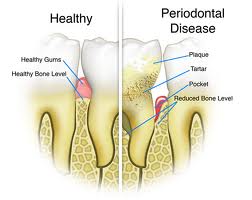 Periodontal Disease
Periodontal Disease
Periodontal means “around the tooth.” Periodontal disease, sometimes referred to as gum disease, harms the gums, exposes the roots of teeth and ultimately destroys the bone supporting the teeth. It is the number one reason for tooth loss. Most people are unaware of the onset of periodontal disease. Unlike tooth decay, which often causes discomfort, it is possible to have periodontal disease without any noticeable symptoms.
Causes
It begins when plaque, a sticky, colorless, film of bacteria, food debris, and saliva, is left on the teeth and gums. Proper brushing, flossing, and regular professional cleanings will ensure that plaque is not left behind to do its damage.
Plaque that stays on the teeth hardens into calculus (tartar), which can only be removed with special dental instruments. The bacteria in plaque and calculus produce toxins (acids) that inflame the gums, cause the gums to recede, and slowly destroy the bone.
Other than poor oral hygiene, other factors that may increase the risk of developing periodontal disease include:
- Many medications – Steroids, cancer therapy drugs, blood pressure medicines, and oral contraceptives
- Smoking or chewing tobacco
- Pregnancy, oral contraceptives, and puberty – These can cause changes in hormone levels, causing gum tissue to become more sensitive to bacteria toxins
- Systemic diseases – Diabetes, blood cell disorders, and HIV / AIDS
Symptoms
Symptoms of periodontal disease include:
- Red and puffy gums – Gums should never be red or swollen
- Bleeding gums – Gums should never bleed, even when you brush vigorously or use dental floss
- Persistent bad breath – Caused by bacteria in the mouth
- New spacing between teeth – Caused by bone loss
- Loose teeth – Also caused by bone loss or weakened periodontal fibers (fibers that support the tooth to the bone)
- Pus around the teeth and gums – Sign that there is an infection present
- Receding gums – Loss of gum around a tooth
- Tenderness or discomfort – Plaque, calculus, and bacteria irritate the gums and teeth
Treatment
Treatment depends on severity of the gum condition.
In the early stages of gingivitis (a precursor to periodontal disease), professional cleanings and improvement in your daily oral hygiene practices.
In more advanced stages of periodontal disease, we do a special periodontal cleaning called scaling and root planing (deep cleaning). Scaling involves removing plaque, tartar and toxins above and below the gum line, and planing involves smoothing rough spots on root surfaces. Medications, special medicated mouth rinses, and an electric tooth brush may be recommended to help control infection and healing.


